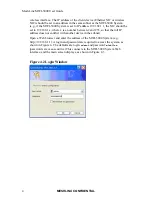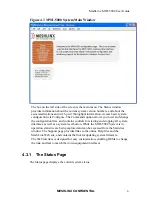
MeshLinx MWI-5000 User Guide
MESHLINX CONFIDENTIAL
2
bridge wif<1|2|3> <ssid> ssid <new-ssid>
- Change the SSID of a
particular bridge.
bridge wif<1|2|3> <ssid> passphrase <string>
- set passphrase to
encrypt the wireless backhaul link, this has to be the same on all
bridge endpoints using this SSID.
bridge wif<1|2|3> dot1q [enabled | disabled]
– enable/disable
802.1Q VLAN tagging on the wireless bridge.
bridge wif<1|2|3> <ssid> security <enabled|disabled>
–
Enable the
use of AES CCMP encryption on the wireless bridge. This utilizes
the pre-shared key specified in the passphrase command.
bridge wif<1|2|3> <ssid> mode <auto <num> |manual>
- Sets the mode
of the bridge SSID. If set to manual, then only 1 bridge endpoint
is allocated/configured on the WIF. If set to auto, multiple bridge
endpoints (up to 16) are allocated on the WIF, and allows the AP to
form as many wireless bridges as needed.
bridge list
- Displays the currently configured wireless bridges.
Example:
To setup a wireless bridge mesh network, configure a number of
MeshLinx AP’s in the following way. In this example, the network
can have up to 5 AP’s, however a user could select up to 16.
set wif3 channel 64
bridge wif3 add bridge-test
bridge wif3 bridge-test security enable
bridge wif3 bridge-test passphrase secret
bridge wif3 dot1q disable
bridge wif3 mode auto 4
# Could be as big as 16
Use the following commands to check the wireless bridge status:
bridge list
cat /proc/management/bridge
4.2.3.22
Bridge Spanning Tree Protocol (STP) Configuration (switch)
set switch stp <enable|disable|auto> - C
ontrols the
enabling/disabling of STP on the AP. “auto” will only turn STP on
when necessary, i.e. when more than one bridge port is enabled on
the access point.
set switch priority <0-65535> - S
ets the bridge priority used by
STP. The industry standard value is 32768 (0x8000). The default
used by the MeshLinx access point is 0x8010, in order to provide
out-of-box compatibility with existing network infrastructures.
set switch ale <10 - 1000000> -
Controls the time (in seconds) a
MAC address will stay in the access points memory before being aged
out.
















































